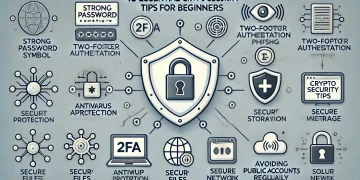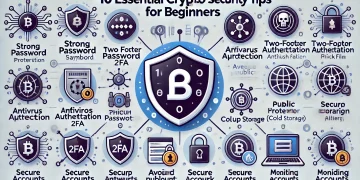Day trading has become one of the most popular ways to profit from the volatility of the cryptocurrency market. Unlike long-term investing, day trading involves buying and selling assets within the same day, often capitalizing on short-term price movements. In the fast-paced world of cryptocurrencies, where prices can swing dramatically in a matter of minutes, day trading offers both incredible profit opportunities and significant risks.
In this comprehensive guide, we will provide you with essential tips and tricks for day trading cryptocurrency in 2024. Whether you’re a seasoned trader or a newcomer looking to make your first trade, this article will help you navigate the volatile world of crypto day trading.
1. What Is Day Trading in Crypto?
Day trading refers to the buying and selling of financial instruments, such as stocks or cryptocurrencies, within the same trading day. The goal is to profit from small price fluctuations, often within a few minutes or hours. For cryptocurrency traders, day trading typically focuses on high-volume coins like Bitcoin (BTC), Ethereum (ETH), and other popular altcoins.
The highly volatile nature of cryptocurrencies makes them ideal for day trading, as prices can rise or fall by several percentage points in a single day, providing opportunities for profit. However, this volatility also means day trading can be risky, requiring skill, strategy, and discipline.
How Crypto Day Trading Works
- Volatility: Traders capitalize on price fluctuations, entering and exiting positions within the same day to lock in profits.
- Technical analysis: Day traders rely on charts, indicators, and patterns to predict short-term price movements.
- Liquidity: Day traders focus on high-liquidity assets, where trades can be executed quickly without impacting the market price.
Example: A day trader might buy Ethereum (ETH) at $1,600 in the morning and sell it at $1,650 later that day, pocketing a $50 profit per ETH before transaction fees.
2. Why Crypto Is Ideal for Day Trading
Cryptocurrency markets operate 24/7, unlike traditional stock markets, which close on weekends and holidays. This constant market activity provides traders with more opportunities to execute trades. Additionally, the cryptocurrency market is highly volatile, meaning prices often move dramatically, creating more chances to profit from small price changes.
Benefits of Day Trading Crypto
- High volatility: Cryptocurrencies are known for their extreme price swings, which day traders can exploit for short-term gains.
- 24/7 markets: Crypto markets never close, providing traders with the flexibility to trade at any time, regardless of geographic location or time zone.
- Accessibility: Thanks to decentralized exchanges (DEXs) and centralized platforms, crypto markets are easily accessible to anyone with an internet connection.
3. Key Factors to Consider Before Day Trading Crypto
Before diving into crypto day trading, it’s essential to understand the key factors that can affect your profitability and risk. While day trading can be lucrative, it’s not without its challenges.
a. Market Volatility
Volatility is both an opportunity and a risk. While it can provide the price swings needed for profitable trades, it can also lead to unexpected losses. Cryptocurrencies are notoriously volatile, with 10% or more price swings in a single day not uncommon.
b. Transaction Fees
Transaction fees, also known as trading fees or gas fees, can eat into your profits. Some exchanges charge as much as 0.1% to 0.2% per trade, while others, like Ethereum, can have high gas fees during periods of network congestion. Traders should be mindful of fees when planning their strategies.
c. Liquidity
Liquidity refers to how easily an asset can be bought or sold without affecting its price. Highly liquid assets, such as Bitcoin or Ethereum, are better suited for day trading because trades can be executed quickly. Illiquid assets, on the other hand, can lead to slippage, where the final execution price is different from the intended price.
d. Technical Skills
Day trading requires a deep understanding of technical analysis. Traders must be familiar with reading charts, understanding candlestick patterns, and using indicators like Relative Strength Index (RSI), Moving Averages (MA), and Bollinger Bands. Without technical skills, it’s easy to misinterpret price movements and make costly mistakes.
4. Essential Day Trading Strategies for Crypto
There are several proven strategies that day traders use to profit from the crypto market. In 2024, these strategies remain popular among successful traders, but they require discipline and an understanding of market mechanics.
a. Scalping
Scalping is one of the most common strategies in crypto day trading. It involves making small, quick trades to capture minimal price movements. Scalpers typically hold positions for minutes, taking advantage of minor price fluctuations to earn small, consistent profits throughout the day.
How It Works:
- Buy a cryptocurrency at a slight dip.
- Sell when the price increases slightly.
- Repeat multiple times in a day to accumulate profits.
Tools: Scalpers often rely on high-frequency trading bots and tight stop-loss orders to minimize losses.
Example: A scalper may buy Solana (SOL) at $22.50 and sell it at $22.55, earning a small profit per trade. By executing dozens of trades like this, a scalper can generate significant returns.
b. Range Trading
Range trading is another popular day trading strategy that involves identifying key support and resistance levels. Traders buy at support (the price floor) and sell at resistance (the price ceiling), profiting from the asset’s movement within a defined range.
How It Works:
- Identify a price range where a cryptocurrency typically fluctuates.
- Buy at the lower boundary (support) and sell at the upper boundary (resistance).
- Continue to trade within this range until a breakout occurs.
Tools: Range traders use technical indicators like Bollinger Bands and Fibonacci retracement levels to identify potential ranges.
Example: If Bitcoin (BTC) trades consistently between $28,000 and $30,000, a range trader would buy at $28,000 and sell near $30,000, repeating this process as long as the range holds.
c. Trend Following
Trend following is a strategy where traders buy into assets that are moving upward and sell assets that are trending downward. The idea is to capitalize on strong trends and ride the momentum until the trend weakens or reverses.
How It Works:
- Identify the direction of the trend using technical indicators like Moving Averages (MA) or MACD (Moving Average Convergence Divergence).
- Enter the market in the direction of the trend (buy in an uptrend or sell in a downtrend).
- Exit the position when the trend shows signs of reversing.
Tools: Traders often use Exponential Moving Averages (EMA) and RSI to confirm trends.
Example: If Ethereum (ETH) is in a clear uptrend, a trend trader might buy ETH at $1,500 and hold the position until the trend weakens, then sell at $1,800 for a profit.
d. Breakout Trading
Breakout trading focuses on price movements that break out of a predefined range. Breakouts occur when the price moves outside of a support or resistance level, signaling a potential continuation of the price movement in the breakout direction.
How It Works:
- Identify key support or resistance levels.
- Wait for the price to “break out” of these levels.
- Enter a trade in the direction of the breakout, with the expectation that the price will continue in that direction.
Tools: Breakout traders use volume analysis and volatility indicators to confirm the strength of a breakout.
Example: If Cardano (ADA) has been trading between $0.90 and $1.00, and the price breaks through $1.00 with increased volume, a breakout trader would enter a long position, anticipating further gains.
5. Tools and Indicators for Day Trading Crypto
To succeed in day trading, you need to equip yourself with the right tools and technical indicators. Here are some essential tools for crypto day traders:
a. Technical Indicators
- Relative Strength Index (RSI): Measures the speed and change of price movements to determine overbought or oversold conditions. An RSI above 70 suggests overbought conditions, while an RSI below 30 suggests oversold conditions.
- Moving Averages (MA): Shows the average price of an asset over a specific time period, helping to identify trends. Simple Moving Average (SMA) and Exponential Moving Average (EMA) are commonly used.
- Bollinger Bands: Helps traders identify volatility and potential price breakouts. The bands expand during periods of high volatility and contract during periods of low volatility.
- Volume Profile: Analyzes trading volume at specific price levels, helping traders understand where the most activity occurs and indicating potential support or resistance levels.
b. Trading Platforms
- Binance: One of the most popular crypto exchanges with a wide range of trading pairs, low fees, and access to leverage.
- Coinbase Pro: Offers a user-friendly interface for day traders, with access to technical charts and real-time price data.
- KuCoin: Known for its variety of altcoins and low fees, KuCoin is ideal for traders looking to capitalize on smaller, more volatile coins.
c. Trading Bots and Automation
Day traders often use automated trading bots to execute trades more efficiently. These bots follow pre-programmed strategies and can enter and exit trades much faster than human traders.
Some popular crypto trading bots in 2024 include:
- 3Commas: A widely used trading bot platform that integrates with multiple exchanges and allows users to create custom strategies using technical indicators.
- Cryptohopper: Another popular trading bot that automates trades based on technical analysis and offers social trading features for users to copy the strategies of more experienced traders.
6. Risk Management for Day Traders
Day trading is inherently risky, and without proper risk management, traders can quickly lose money. Effective risk management strategies can help mitigate potential losses while maximizing profits.
a. Setting Stop-Loss and Take-Profit Orders
A stop-loss order automatically sells your assets when the price reaches a predetermined level, limiting your losses. A take-profit order, on the other hand, automatically closes your position when the asset hits a certain profit level.
Example: If you buy Bitcoin at $30,000 and set a stop-loss at $29,500, your position will automatically sell if the price falls to $29,500, minimizing your losses.
b. Using the 1% Rule
Many professional traders follow the 1% rule, which states that you should never risk more than 1% of your total trading capital on a single trade. This helps limit losses and ensures that a string of bad trades won’t wipe out your account.
Example: If you have $10,000 in your trading account, you should risk no more than $100 on any single trade.
c. Diversification
Diversifying your trading portfolio can help reduce risk. Instead of putting all your capital into one asset, spread your trades across multiple cryptocurrencies. This minimizes the impact of a sudden price drop in any one asset.
7. Psychological Factors in Day Trading
Day trading is as much a psychological battle as it is a technical one. Managing emotions like fear and greed is essential to becoming a successful day trader.
a. Controlling Emotions
Fear of missing out (FOMO) or panic selling during price dips can lead to impulsive decisions that result in losses. Traders must stay calm, stick to their strategy, and avoid making emotional trades.
b. Avoid Overtrading
Overtrading occurs when a trader executes too many trades in a short period, often driven by the excitement of making quick profits. This can lead to mistakes and increased transaction fees, reducing overall profitability. Stick to a well-defined strategy and avoid trading for the sake of trading.
8. Common Mistakes to Avoid in Day Trading Crypto
While day trading offers significant opportunities for profit, it’s easy to make mistakes that can lead to losses. Here are some common pitfalls to avoid:
a. Ignoring Market News
Cryptocurrency prices are heavily influenced by news events, regulatory announcements, and market sentiment. Ignoring the news can leave you unprepared for sudden price swings.
Example: A negative regulatory announcement from a major country can cause the price of Bitcoin to plummet. Traders who ignore such developments may find themselves on the wrong side of a trade.
b. Not Using Stop-Losses
Failing to set stop-losses can result in massive losses if the market moves against you. Always use stop-loss orders to limit your downside.
c. Trading Illiquid Coins
Trading coins with low liquidity can result in significant slippage, where the price moves against you as your order is executed. Stick to high-liquidity assets, especially as a beginner.
9. Legal and Tax Implications of Day Trading Crypto
In many jurisdictions, cryptocurrency day trading is subject to taxation. Profits made from day trading are typically treated as capital gains or income, depending on the country’s tax laws.
a. Record Keeping
Keep detailed records of all your trades, including the date, price, and amount of cryptocurrency bought or sold. This will make it easier to calculate your taxable gains or losses at the end of the year.
b. Tax Strategies
In some countries, you may be able to offset your gains with losses from other trades, reducing your overall tax liability. Consult with a tax professional to understand the rules in your jurisdiction.
Example: In the U.S., profits from day trading crypto are subject to short-term capital gains tax, which is higher than long-term capital gains. Accurate record-keeping is essential for tax reporting.
Conclusion: Mastering Day Trading Crypto in 2024
Day trading cryptocurrency can be highly profitable, but it requires skill, discipline, and a well-planned strategy. By understanding the key factors that influence the market, mastering technical analysis, and implementing effective risk management techniques, you can increase your chances of success. However, it’s important to remember that day trading is not without risks. The volatile nature of cryptocurrencies means that prices can move against you quickly, so always trade with caution and never invest more than you can afford to lose.
With the right mindset, tools, and strategies, you can navigate the exciting world of crypto day trading and capitalize on the opportunities that arise in 2024.






























